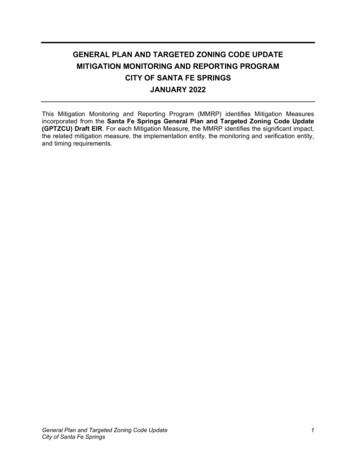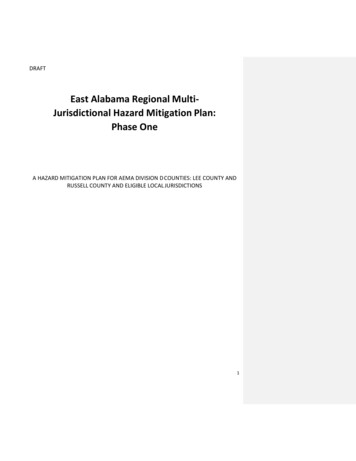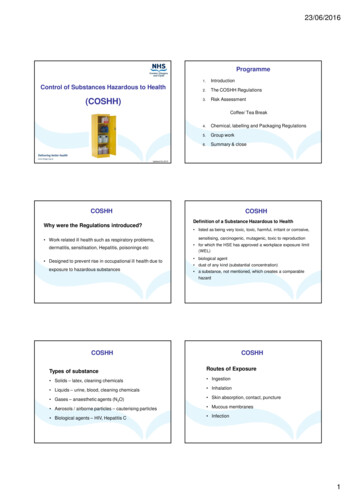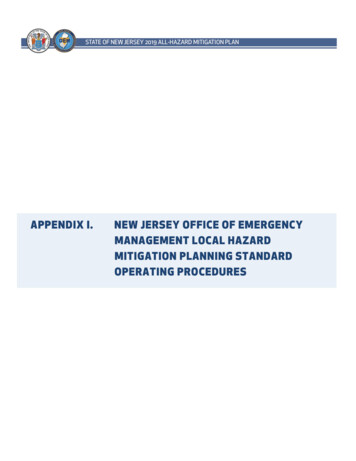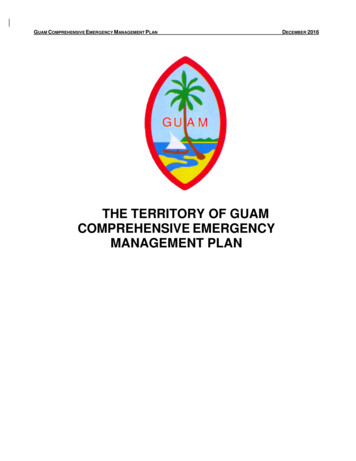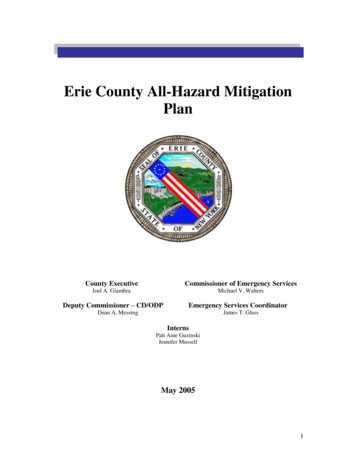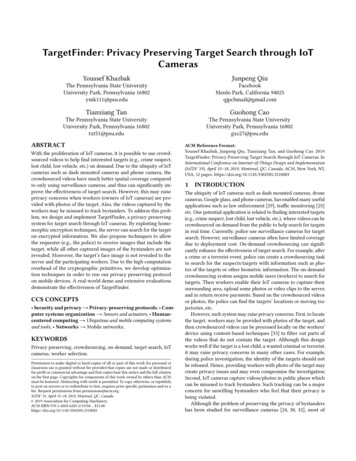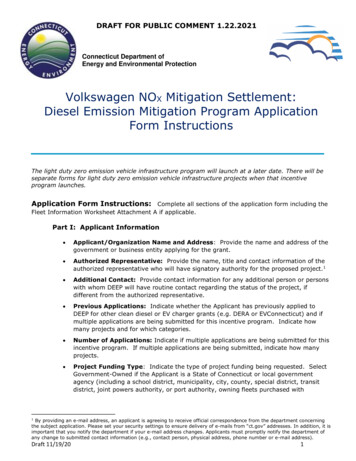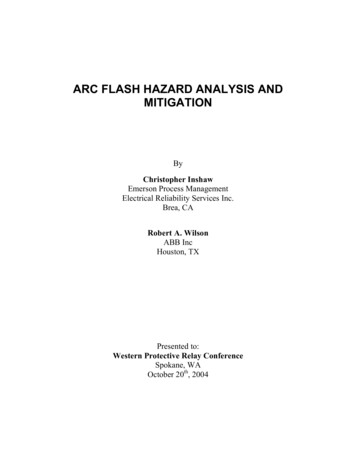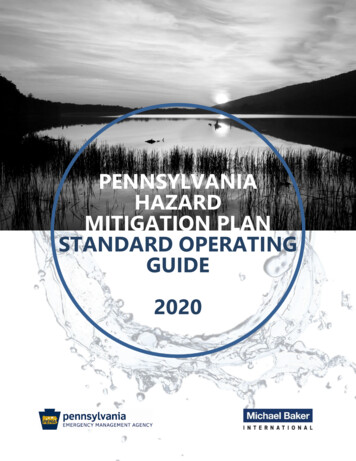
Transcription
PENNSYLVANIAHAZARDMITIGATION PLANSTANDARD OPERATINGGUIDE2020
PENNSYLVANIA HAZARD MITIGATION PLAN STANDARD OPERATING GUIDETable of ContentsCounty Hazard Mitigation Plan (HMP) Update Suggested Schedule . ivHazard Mitigation Planning Checklist . vii1 Introduction . 11.11.21.31.4Overview . 1Multi-Jurisdictional Planning . 3State Hazard Mitigation Plan. 3Authority and References . 42 3 4 Planning Process . 6Community Profile . 13Risk Assessment . 164.14.24.3Identifying Hazards . 16Profiling Hazards . 19Assessing Vulnerability. 235 6 Capability Assessment . 30Mitigation Strategy. 336.16.26.36.4Evaluating Existing Hazard Mitigation Goals, Objectives, and Action Plan . 33Update Mitigation Goals and Objectives . 35Evaluating Mitigation Techniques for Profiled Hazards . 38Developing the Mitigation Action Plan . 407 8 9 10 Appendix 1 Appendix 2 Appendix 3 Appendix 4 Appendix 5 Appendix 6 Appendix 7 Appendix 8 Appendix 9 Appendix 10 Appendix 11 Appendix 12 Appendix 13 Appendix 14 Plan Maintenance . 45Plan Introduction. 47Plan Adoption . 48Mitigation Action Implementation . 50Model Plan Outline. 55Community Participation Table . 58Capability Assessment Survey . 59Hazard Identification and Risk Evaluation Worksheet . 65Pennsylvania Presidential Disaster Declarations. 67Risk Assessment Hazard Descriptions . 74Mitigation Strategy 5-Year Mitigation Plan Review . 83Hazard Prioritization Matrix . 87Mitigation Strategy Technique Matrix . 88Mitigation Action Assessment . 89Mitigation Strategy Action Plan Template . 90Jurisdiction Action Matrix . 91Adoption Resolutions . 92Risk Assessment Hazard Data Sources . 94ii
PENNSYLVANIA HAZARD MITIGATION PLAN STANDARD OPERATING GUIDEAppendix 15 Appendix 16 Appendix 17 Appendix 18 Appendix 19 Checklist to Identify Local Compliance with the NFIP . 102Jurisdictional Risk Comparison Matrix . 104Data Requirements for Historic and Cultural Resources . 105Historic and Cultural Resources Potential Funding Sources . 108Hazard Mitigation Assistance (HMA) Forms . 110iii
PENNSYLVANIA HAZARD MITIGATION PLAN STANDARD OPERATING GUIDECounty Hazard Mitigation Plan (HMP) Update Suggested ScheduleTask3 YEARS BEFORE PLAN EXPIRESApply for HazardMitigationAssistanceBuild the PlanningTeamObtain existingFEMA LocalMitigation PlanReview Tool2 YEARS BEFORE PLAN EXPIRESHold SteeringCommitteeMeetingsHold Initial PublicKickoff Meeting*Review DescriptionCall for assistance. The most likely source of funding isHazard Mitigation Assistance (HMA) grants. The grantapplications are submitted through PEMA via the ‘Egrants’ system. The process normally takes 12 monthsfrom application to funding award.Review the existing HMP to gather former PlanningTeam participant information. Contact Planning Teammembers and other stakeholders as needed, in writing,to re-establish the Planning Team. Consider expandingthe Planning Team and include all potentialstakeholders, every organization that has assets in yourcounty, passes through your county or could be affectedby hazards in your county. Invite lots of people, you arenot responsible if they don’t participate, but areresponsible for inviting them. Document the invitationprocess and the responses.The existing FEMA Local Plan Review Tool will havecomments and suggested or required improvementsassociated with the current hazard mitigation plan. Acopy of the existing review tool can be obtained fromFEMA.The Steering Committee is the smaller group ofindividuals (typically 2-5 members) that drive theplanning process and ‘plan to plan’. The SteeringCommittee will organize and conduct Planning Team andPublic meetings and dictate the HMP update schedule.The Steering Committee should meet regularly (inperson and/or virtually) throughout the HMP updateprocess.Hold a Kickoff Meeting with the Planning Team and thePublic to inform them about HMP update. Gatherinformation to inform Risk Assessment and CapabilityAssessment.Review applicable planning documents, studies, reportsand technical information that may exist that wouldenhance the plan update and should be considered forincorporation into your plan. Examples are the countycomprehensive plan, economic development plan andfloodplain management ordinances.Summarize community characteristics includinggeography, demographics, and environmental featuresof a county and the jurisdictions.CompleteSOGSection36 monthsbefore HMPexpiration10More than24 monthsbefore HMPexpiration2More than24 monthsbefore HMPexpiration1, 8More than24 monthsbefore HMPexpiration224 monthsbefore HMPexpiration2, 4, 524- 20monthsbefore HMPexpiration2, 520 monthsbefore HMPexpiration3iv
2 YEARS BEFORE PLAN EXPIRES (CONTINUED)PENNSYLVANIA HAZARD MITIGATION PLAN STANDARD OPERATING GUIDETaskDescriptionCompleteSOGSectionProfile Hazards**Continue collecting data and determine the location andextent, the range of magnitude, past occurrence andprobability of future occurrence for each hazard.20 - 18monthsbefore HMPexpiration4.218 monthsbefore HMPexpiration4.318 monthsbefore HMPexpiration418 monthsbefore HMPexpiration2, 418 - 12monthsbefore HMPexpiration2, 512 monthsbefore HMPexpiration2, 6AssessVulnerability**Complete RiskAssessmentHold Public RiskAssessmentReview Meeting*CompleteCapabilityAssessment3-12 MONTHS BEFORE PLAN EXPIRESHold MitigationSolutionsWorkshop*Continue collecting data and, using hazard profiles,summarize vulnerable assets (i.e. people, structures,critical facilities, infrastructure), estimate losses anddevelop a risk factor for each hazard.Consolidate information from the Risk Assessment inputfrom Steering Committee and Public Kick-off Meetings,the hazard profiles and the vulnerability assessmentsand draft the Risk Assessment section of the plan.Hold a Risk Assessment Review Meeting with thePlanning Team and the Public to review risk assessmentfindings.Consolidate information from the Capability Assessmentinput from Steering Committee and Public Kick-offMeetings, existing planning mechanisms review, andother data collection to draft the Capability Assessmentsection of the plan.Hold a Mitigation Solutions Workshop with the PlanningTeam to evaluate and update existing goals, objectivesand actions. Each participating jurisdiction must have atleast one mitigation action. Collect input to inform thePlan Maintenance Section.CompleteMitigation ActionPlanDocument information obtained from the MitigationSolutions Workshop and update the Mitigation ActionPlan.Complete PlanMaintenanceSection**Document any information obtained from the SteeringCommittee and update the Plan Maintenance section ofthe plan.Complete DraftHMPConsolidate and review all sections of the plan. Preparea draft document.Hold Public DraftPlan ReviewMeeting*Hold a Meeting with the Planning Team and Public toreview the draft plan.Provide a PublicReview andComment PeriodMake the Draft HMP available for public review andcomment for a minimum of 30 days. Post the Draft HMPon a project or county website and provided placeprinted copies at the county, public library, etc.12 - 9monthsbefore HMPexpiration9 monthsbefore HMPexpiration9 - 6 monthsbefore HMPexpiration6 monthsbefore HMPexpiration6 monthsbefore HMPexpiration6.47All22v
PENNSYLVANIA HAZARD MITIGATION PLAN STANDARD OPERATING GUIDEDescriptionCompleteSOGSectionComplete FinalHMPMake all necessary revisions based on Planning Teamand public comment and feedback and prepare the finalproduct for submission.6 - 3 monthsbefore HMPexpirationAllSubmit Final HMPto PEMASubmit the final plan to the State Hazard MitigationOfficer who will review, return for edits (if needed),approve, and then forward to FEMA for review.At Least 90days beforeHMPexpiration9Before HMPexpiration9Before HMPexpiration9FINAL 3 MONTHSTaskReceive FEMA“ApprovalPendingAdoption” noticeAdopt FEMAapproved planFEMA may request additional information anddocumentation. Once FEMA determines the HMPsatisfies all requirements, you will receive a letter statingthat the plan has been Approved Pending Adoption(APA).Once APA has been received, each participatingjurisdiction and the county must adopt the plan. Followlocal guidelines and requirements for public noticeassociated with adoption resolution.* Three to four community and stakeholder meetings are the minimum requirement for HMP update. The DraftPlan Review Meeting should be advertised in the local newspaper a minimum of 7 days prior to the meeting date.Counties and municipalities should conduct virtual outreach by posting the planning process on their website toencourage wider participation.** Data collection should be continuous – don’t wait for the next HMP update! Posting the HMP with acorresponding comment mechanism or form on the county website will encourage stakeholders to provide dataand feedback continuously.vi
PENNSYLVANIA HAZARD MITIGATION PLAN STANDARD OPERATING GUIDEHazard Mitigation Planning ChecklistSTEPS AND CORRESPONDING PRODUCTSPLANNING PROCESSStep 1: Build the Planning Team.COMPLETE1) List of participants and roles.2) Description of each jurisdiction’s participation.3) Discussion of past participation in the previously adopted plan.Step 2: Gather Tools.1) Inventory of existing HMP planning documentation.Step 3: Create a Workspace.1) Designate physical and virtual workspace.Step 4: Engage the Public and Other Stakeholders.1) A description of all meetings and forums.2) A description of stakeholder involvement (neighboring communities, agencies).3) A description of tools (worksheets and surveys) distributed to meeting and forumparticipants.4) A compilation of meeting and outreach materials.5) Documentation of public notice(s) and comments received.Step 5: Sustain Outreach Activities During the Planning Process.1) An HMP update and outreach schedule.Step 6: Document the Approach to Updating Each Section of the Plan.1) Description of the process followed to prepare the HMP update and any changes thatoccurred.2) A table summarizing changes to previously adopted plan.COMMUNITY PROFILEStep 1: Describe Geography and the Environment.1) Description of the county’s geographical location, land area, and water features.2) A base map for the county.Step 2: Describe Community; Include Relevant Facts.1) Description of the county and its jurisdictions that includes history, major industries,primary land uses, etc.2) Identify the location of known historic and cultural resources within the communitythat are vulnerable to natural hazards and identify areas that may need additionalinventory.Step 3: Summarize Demographics.1) Demographic summary including population, population density, racial composition,age breakdown, income, etc.2) Population table listing each municipality.Step 4: Describe Growth Trends and Land Use.1) Summary of growth trends, including population growth, changing land use, and theoverall extent of developed area, including how they have increased the community’svulnerability or resiliency to hazards.vii
PENNSYLVANIA HAZARD MITIGATION PLAN STANDARD OPERATING GUIDESTEPS AND CORRESPONDING PRODUCTSCOMPLETE2) A map of existing land use for the county.Step 5: Describe Data Sources and Limitations.1) Describe/discuss sources used to complete the plan update and any data limitationsencountered, as well as opportunities for continued data gathering, updating, andcoordination.RISK ASSESSMENTIdentifying HazardsStep 1: Document Past Presidential Disaster Declarations.1) A table of past, applicable presidential disaster declarations.Step 2: Develop a List of Natural and Human-made Hazards.1) Comprehensive, descriptive list of all natural and human-made hazards profiled in theplan update.Profiling HazardsStep 1: Identify the Geographic Location.1) Map with summary illustrating the location or geographical extent of each hazard.Step 2: Define the Magnitude.1) Summary of the potential hazard magnitude or severity.Step 3: Profile Past Occurrences.1) Discussion of past hazard occurrences that includes the date(s), severity, loss, and eventduration.Step 4: Summarize Repetitive Loss Properties (Flood Hazard Only).1) Table Summarizing number and structure type of RL and SRL properties in eachcommunity.Step 5: Establish Probability of Future Occurrence.1) Assessment of future hazard probability.Step 6: Determine Environmental Impacts.1) List or discussion of potential environmental impacts from hazards.Assessing VulnerabilityStep 1: Identify and Summarize Vulnerable Assets.1) Table of critical facilities by municipality and corresponding hazard area overlap.2) Overall summary of vulnerability to each hazard, documenting the impact of eachhazard, including vulnerability of historic and cultural resources, such as importantcultural institutions.3) Flood vulnerability maps for each jurisdiction (Flood Hazard only).4) Summary of vulnerability for repetitive loss properties (Flood Hazard only).5) Document process used to identify and continually update existing vulnerable assets,including historic and cultural resources.Step 2: Estimate Loss.1) Estimate of potential dollar losses to vulnerable assets.2) Description of methodology used to prepare dollar loss estimates.Step 3: Characterize Repetitive Loss Properties (Flood Only).1) Estimate of dollar losses to repetitive loss properties.viii
PENNSYLVANIA HAZARD MITIGATION PLAN STANDARD OPERATING GUIDESTEPS AND CORRESPONDING PRODUCTSCOMPLETE2) Description of land use and development within repetitive loss areas.Step 4: Develop Risk Factor for Profiled Hazards.1) Table showing Risk Factors and hazard rankings.2) Description of risk factor methodology.3) Table depicting jurisdictional hazard risk.Step 5: Describe Asset Vulnerability of Future Development.1) Description of how future land uses and development trends are expected to impactvulnerability.CAPABILITY ASSESSMENTStep 1: Complete the Capability Assessment Survey.1) Completed Capability Assessment Survey for each participating jurisdiction and thecounty.Step 2: Compile and Analyze Information from the Capability Assessment.1) Complete capability inventory including a table of planning tools.2) Descriptions of all local capabilities and existing limitations.3) Completed Self-Assessment Capability Matrix.Step 3: Determine Participation in the National Flood Insurance Program (NFIP).1) Completed NFIP Checklist(s).2) Description of the level of participation and NFIP compliance.Step 4: Describe integration with existing planning mechanisms.1) Summary of how the hazard mitigation has been or will be integrated into existing plansand programs and how other planning mechanisms have been incorporated into thehazard mitigation plan.MITIGATION STRATEGYEvaluating Existing Hazard Mitigation Goals, Objectives, and Action PlanStep 1: Review the Existing Mitigation Plan Goals and Objectives.1) Summary table of information collected from the Goal and Objective ReviewWorksheet.2) Compilation of Goal and Objective Review Worksheets.Step 2: Review the Existing Mitigation Action Plan.1) Summary table of information collected from the Mitigation Action Plan ReviewWorksheet.2) Compilation of Mitigation Action Plan Review Worksheets.Updating Mitigation Goals and ObjectivesStep 1: Review Key Items.1) A narrative of the evaluation of the updated risk and capability assessments andexisting goals and objectives.Step 2: Develop Mitigation Goals and Objectives.1) List of updated mitigation goals and objectives with applicable public participationdocumentation.Step 3: Include Goals and Objectives Related to NFIP Requirements.1) List of goals and objectives related to continued NFIP compliance.ix
PENNSYLVANIA HAZARD MITIGATION PLAN STANDARD OPERATING GUIDESTEPS AND CORRESPONDING PRODUCTSCOMPLETEEvaluating Mitigation Techniques for Profiled HazardsStep 1: Review the Four Categories of Mitigation Techniques.Step 2: Complete the Mitigation Technique Matrix.1) Matrix of hazards and corresponding mitigation techniques.Developing the Mitigation Action PlanStep 1: Brainstorm Possible Mitigation Actions.1) Description of how mitigation actions were selected.Step 2: Include NFIP-Related Mitigation Actions.1) List of NFIP mitigation actions related to continuing compliance with NFIP regulations.Step 3: Evaluate and Prioritize Mitigation Actions.1) Description of the processes followed to evaluate and prioritize mitigation actions,including consideration of whether certain mitigation techniques are more or lessappropriate for historic buildings and other local resources that are uniquely important.2) Mitigation Action Evaluation table.Step 4: Develop Mitigation Action Plans for Each Participating Jurisdiction.1) Mitigation action plan which includes actions for each participating jurisdiction.PLAN MAINTENANCEStep 1: Update the Process for Monitoring, Evaluating, and Updating the HMP.1) A description of the methodology to maintain plan over five-year cycle.2) Tables documenting annual meetings held by the planning team and any changes madeto the plan (between updates).Step 2: Describe Continued Public Participation.1) Description of how public participation will be maintained over the next five years.INTRODUCTIONStep 1: Complete Background Information.1) Background section with information on hazard mitigation planning and preparation.Step 2: Develop Purpose.1) Description of purpose for hazard mitigation plan development.Step 3: Prepare Scope.1) Description of the scope for the plan.Step 4: Document Authority and References.1) List of federal, state and local authorities and references.PLAN ADOPTIONStep 1: Submit Updated Hazard Mitigation Plan.1) A complete, updated plan submitted to PEMA’s State Hazard Mitigation Officer.2) A completed Local Mitigation Plan Review Tool.Step 2: Submit Documentation of Formal Adoption.1) Documentation on resolution of formal adoption by all participating jurisdictions.x
LOCAL MITIGATION PLAN REVIEW TOOL2020The Local Mitigation Plan Review Tool demonstrates how the Local Mitigation Plan meets theregulation in 44 CFR §201.6 and offers States and FEMA Mitigation Planners an opportunity toprovide feedback to the community. The Regulation Checklist provides a summary of FEMA’s evaluation of whether the Plan hasaddressed all requirements.The Plan Assessment identifies the plan’s strengths as well as documents areas for futureimprovement.The Multi-jurisdiction Summary Sheet is an optional worksheet that can be used todocument how each jurisdiction met the requirements of each Element of the Plan(Planning Process; Hazard Identification and Risk Assessment; Mitigation Strategy; PlanReview, Evaluation, and Implementation; and Plan Adoption).The FEMA Mitigation Planner must reference this Local Mitigation Plan Review Guide whencompleting the Local Mitigation Plan Review Tool.Jurisdiction:Title of Plan:Local Point of Contact:Date of Plan:Address:Title:Agency:Phone Number:E-Mail:State Reviewer:Title:Date:FEMA Reviewer:Title:Date:Date Received in FEMA Region (insert #)Plan Not ApprovedPlan Approvable Pending AdoptionPlan ApprovedLocal Mitigation Plan Review Tool (2020)xi
SECTION 1:REGULATION CHECKLISTINSTRUCTIONS: The Regulation Checklist must be completed by FEMA. The purpose of the Checklistis to identify the location of relevant or applicable content in the Plan by Element/sub-element andto determine if each requirement has been ‘Met’ or ‘Not Met.’ The ‘Required Revisions’ summary atthe bottom of each Element must be completed by FEMA to provide a clear explanation of therevisions that are required for plan approval. Required revisions must be explained for each plansub-element that is ‘Not Met.’ Sub-elements should be referenced in each summary by using theappropriate numbers (A1, B3, etc.), where applicable. Requirements for each Element and subelement are described in detail in this Plan Review Guide in Section 4, Regulation Checklist.1. REGULATION CHECKLISTRegulation (44 CFR 201.6 Local Mitigation Plans)Location in Plan(section and/orpage number)MetNotMetELEMENT A. PLANNING PROCESSA1. Does the Plan document the planning process, including how itwas prepared and who was involved in the process for eachjurisdiction? (Requirement §201.6(c)(1))A2. Does the Plan document an opportunity for neighboringcommunities, local and regional agencies involved in hazardmitigation activities, agencies that have the authority to regulatedevelopment as well as other interests to be involved in theplanning process? (Requirement §201.6(b)(2))A3. Does the Plan document how the public was involved in theplanning process during the drafting stage? (Requirement§201.6(b)(1))A4. Does the Plan describe the review and incorporation of existingplans, studies, reports, and technical information? (Requirement§201.6(b)(3))A5. Is there discussion of how the community(ies) will continuepublic participation in the plan maintenance process? (Requirement§201.6(c)(4)(iii))A6. Is there a description of the method and schedule for keepingthe plan current (monitoring, evaluating and updating themitigation plan within a 5-year cycle)? (Requirement §201.6(c)(4)(i))ELEMENT A: REQUIRED REVISIONSELEMENT B. HAZARD IDENTIFICATION AND RISK ASSESSMENTLocal Mitigation Plan Review Tool (2020)xii
1. REGULATION CHECKLISTRegulation (44 CFR 201.6 Local Mitigation Plans)B1. Does the Plan include a description of the type, location, andextent of all natural hazards that can affect each jurisdiction(s)?(Requirement §201.6(c)(2)(i))B2. Does the Plan include information on previous occurrences ofhazard events and on the probability of future hazard events foreach jurisdiction? (Requirement §201.6(c)(2)(i))B3. Is there a description of each identified hazard’s impact on thecommunity as well as an overall summary of the community’svulnerability for each jurisdiction? (Requirement §201.6(c)(2)(ii))B4. Does the Plan address NFIP insured structures within thejurisdiction that have been repetitively damaged by floods?(Requirement §201.6(c)(2)(ii))ELEMENT B: REQUIRED REVISIONSLocation in Plan(section and/orpage number)MetNotMetELEMENT C. MITIGATION STRATEGYC1. Does the plan document each jurisdiction’s existing authorities,policies, programs and resources and its ability to expand on andimprove these existing policies and programs? (Requirement§201.6(c)(3))C2. Does the Plan address each jurisdiction’s participation in theNFIP and continued compliance with NFIP requirements, asappropriate? (Requirement §201.6(c)(3)(ii))C3. Does the Plan include goals to reduce/avoid long-termvulnerabilities to the identified hazards? (Requirement§201.6(c)(3)(i))C4. Does the Plan identify and analyze a comprehensive range ofspecific mitigation actions and projects for each jurisdiction beingconsidered to reduce the effects of hazards, with emphasis on newand existing buildings and infrastructure? (Requirement§201.6(c)(3)(ii))C5. Does the Plan contain an action plan that describes how theactions identified will be prioritized (including cost benefit review),implemented, and administered by each jurisdiction? (Requirement§201.6(c)(3)(iv)); (Requirement §201.6(c)(3)(iii))C6. Does the Plan describe a process by which local governmentswill integrate the requirements of the mitigation plan into otherplanning mechanisms, such as comprehensive or capitalimprovement plans, when appropriate? (Requirement§201.6(c)(4)(ii))ELEMENT C: REQUIRED REVISIONSLocal Mitigation Plan Review Tool (2020)xiii
1. REGULATION CHECKLISTRegulation (44 CFR 201.6 Local Mitigation Plans)Location in Plan(section and/orpage number)MetNotMetELEMENT D. PLAN REVIEW, EVALUATION, AND IMPLEMENTATION (applicable to plan updates only)D1. Was the plan revised to reflect changes in development?(Requirement §201.6(d)(3))D2. Was the plan revised to reflect progress in local mitigationefforts? (Requirement §201.6(d)(3))D3. Was the plan revised to reflect changes in priorities?(Requirement §201.6(d)(3))ELEMENT D: REQUIRED REVISIONSELEMENT E. PLAN ADOPTIONE1. Does the Plan include documentation that the plan has beenformally adopted by the governing body of the jurisdictionrequesting approval? (Requirement §201.6(c)(5))E2. For multi-jurisdictional plans, has each jurisdiction requestingapproval of the plan documented formal plan adoption?(Requirement §201.6(c)(5))ELEMENT E: REQUIRED REVISIONSOPTIONAL: HIGH HAZARD POTENTIAL DAM (HHPD) RISKSHHPD1. Did Element A4 (planning process) describe theincorporation of existing plans, studies, reports, and technicalinformation for high hazard potential dams?HHPD2. Did Element B3 (risk assessment) address HHPDs?HHPD3. Did Element C3 (mitigation goals) include mitigation goalsto reduce long-term vulnerabilities from high hazard potential damsthat pose an unacceptable risk to the public?HHPD4. Did Element C4-C5 (mitigation actions) address HHPDsprioritize mitigation actions to reduce vulnerabilities from highhazard potential dams that pose an unacceptable risk to the public?REQUIRED REVISIONSELEMENT F. ADDITIONAL STATE REQUIREMENTS (OPTIONAL FOR STATE REVIEWERS ONLY; NOTTO BE COMPLETED BY FEMA)F1.F2.ELEMENT F: REQUIRED REVISIONSLocal Mitigation Plan Review Tool (2020)xiv
SECTION 2:PLAN ASSESSMENTINSTRUCTIONS: The purpose of the Plan Assessment is to offer the local community morecomprehensive feedback to the community on the quality and utility of the plan in a narrativeformat. The audience for the Plan Assessment is not only the plan developer/local communityplanner, but also elected officials, local departments and agencies, and others involved inimplementing the Local Mitigation Plan. The Plan Assessment must be completed by FEMA. TheAssessment is an opportunity for FEMA to provide feedback and information to the community on:1) suggested improvements to the Plan; 2) specific sections in the Plan where the community hasgone above and beyond minimum requirements; 3) recommendations for plan implementation; and4) ongoing partnership(s) and information on other FEMA programs, specifically Risk MAP andHazard Mitigation Assistance programs. The Plan Assessment is divided into two sections:1.2.Plan Strengths and Opportunities for ImprovementResources for Implementing Your Approved PlanPlan Strengths and Opportunities for Improvement is organized according to the plan Elementslisted in the Regulation Checklist. Each Element includes a series of italicized bulleted items that aresuggested topics for consideration while evaluating plans, but it is not intended to be acomprehensive list. FEMA Mitigation Planners are not required to answer each bullet item andshould use them as a guide to paraphrase their own written assessment (2-3 sentences) of eachElement.The Plan Assessment must not reiterate the required revisions from the Regulation Checklist or beregulatory in nature and should be open-ended and to provide the community with suggestions forimprovements or recommended revisions. The recommended revisions are suggestions forimprovement and are not required to be made for the Plan to meet Federal regulatoryrequirements. The italicized text should be deleted once FEMA has added comments regardingstrengths of the plan and potential improvements for future plan revisions. It is recommended thatthe Plan Assessment be a short synopsis of the overall strengths and weaknesses of the Plan (nolonger than two pages), rather than a complete recap section by section.Resources for Implementing Your Approved Plan provides a place for FEMA to offer information,data sources and general suggestions on the plan implementation and maintenance process.Information on other possible sources of assistance including, but not limited to, existingpublications, grant funding or training opportunities, can be provided. Stat
Assessing Vulnerability Step 1: Identify and Summarize Vulnerable Assets. 1) Table of critical facilities by municipality and corresponding hazard area overlap. 2) Overall summary of vulnerability to each hazard, documenting the impact of each hazard, including vulnerability of historic and cultural resources, such as important

